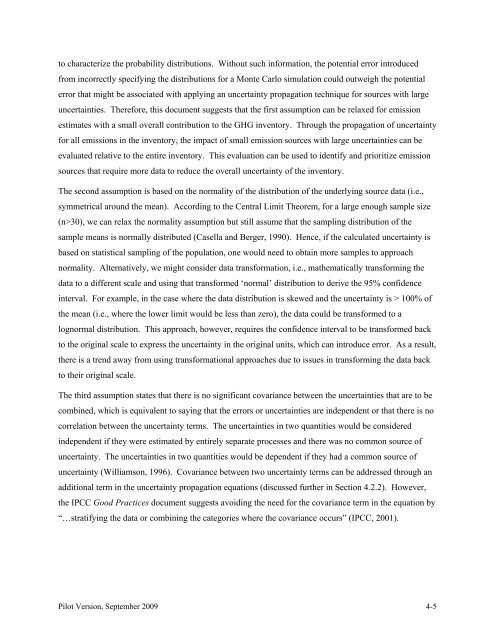addressing uncertainty in oil and natural gas industry greenhouse
addressing uncertainty in oil and natural gas industry greenhouse
addressing uncertainty in oil and natural gas industry greenhouse
You also want an ePaper? Increase the reach of your titles
YUMPU automatically turns print PDFs into web optimized ePapers that Google loves.
to characterize the probability distributions. Without such <strong>in</strong>formation, the potential error <strong>in</strong>troduced<br />
from <strong>in</strong>correctly specify<strong>in</strong>g the distributions for a Monte Carlo simulation could outweigh the potential<br />
error that might be associated with apply<strong>in</strong>g an <strong>uncerta<strong>in</strong>ty</strong> propagation technique for sources with large<br />
uncerta<strong>in</strong>ties. Therefore, this document suggests that the first assumption can be relaxed for emission<br />
estimates with a small overall contribution to the GHG <strong>in</strong>ventory. Through the propagation of <strong>uncerta<strong>in</strong>ty</strong><br />
for all emissions <strong>in</strong> the <strong>in</strong>ventory, the impact of small emission sources with large uncerta<strong>in</strong>ties can be<br />
evaluated relative to the entire <strong>in</strong>ventory. This evaluation can be used to identify <strong>and</strong> prioritize emission<br />
sources that require more data to reduce the overall <strong>uncerta<strong>in</strong>ty</strong> of the <strong>in</strong>ventory.<br />
The second assumption is based on the normality of the distribution of the underly<strong>in</strong>g source data (i.e.,<br />
symmetrical around the mean). Accord<strong>in</strong>g to the Central Limit Theorem, for a large enough sample size<br />
(n>30), we can relax the normality assumption but still assume that the sampl<strong>in</strong>g distribution of the<br />
sample means is normally distributed (Casella <strong>and</strong> Berger, 1990). Hence, if the calculated <strong>uncerta<strong>in</strong>ty</strong> is<br />
based on statistical sampl<strong>in</strong>g of the population, one would need to obta<strong>in</strong> more samples to approach<br />
normality. Alternatively, we might consider data transformation, i.e., mathematically transform<strong>in</strong>g the<br />
data to a different scale <strong>and</strong> us<strong>in</strong>g that transformed ‘normal’ distribution to derive the 95% confidence<br />
<strong>in</strong>terval. For example, <strong>in</strong> the case where the data distribution is skewed <strong>and</strong> the <strong>uncerta<strong>in</strong>ty</strong> is > 100% of<br />
the mean (i.e., where the lower limit would be less than zero), the data could be transformed to a<br />
lognormal distribution. This approach, however, requires the confidence <strong>in</strong>terval to be transformed back<br />
to the orig<strong>in</strong>al scale to express the <strong>uncerta<strong>in</strong>ty</strong> <strong>in</strong> the orig<strong>in</strong>al units, which can <strong>in</strong>troduce error. As a result,<br />
there is a trend away from us<strong>in</strong>g transformational approaches due to issues <strong>in</strong> transform<strong>in</strong>g the data back<br />
to their orig<strong>in</strong>al scale.<br />
The third assumption states that there is no significant covariance between the uncerta<strong>in</strong>ties that are to be<br />
comb<strong>in</strong>ed, which is equivalent to say<strong>in</strong>g that the errors or uncerta<strong>in</strong>ties are <strong>in</strong>dependent or that there is no<br />
correlation between the <strong>uncerta<strong>in</strong>ty</strong> terms. The uncerta<strong>in</strong>ties <strong>in</strong> two quantities would be considered<br />
<strong>in</strong>dependent if they were estimated by entirely separate processes <strong>and</strong> there was no common source of<br />
<strong>uncerta<strong>in</strong>ty</strong>. The uncerta<strong>in</strong>ties <strong>in</strong> two quantities would be dependent if they had a common source of<br />
<strong>uncerta<strong>in</strong>ty</strong> (Williamson, 1996). Covariance between two <strong>uncerta<strong>in</strong>ty</strong> terms can be addressed through an<br />
additional term <strong>in</strong> the <strong>uncerta<strong>in</strong>ty</strong> propagation equations (discussed further <strong>in</strong> Section 4.2.2). However,<br />
the IPCC Good Practices document suggests avoid<strong>in</strong>g the need for the covariance term <strong>in</strong> the equation by<br />
“…stratify<strong>in</strong>g the data or comb<strong>in</strong><strong>in</strong>g the categories where the covariance occurs” (IPCC, 2001).<br />
Pilot Version, September 2009 4-5

















